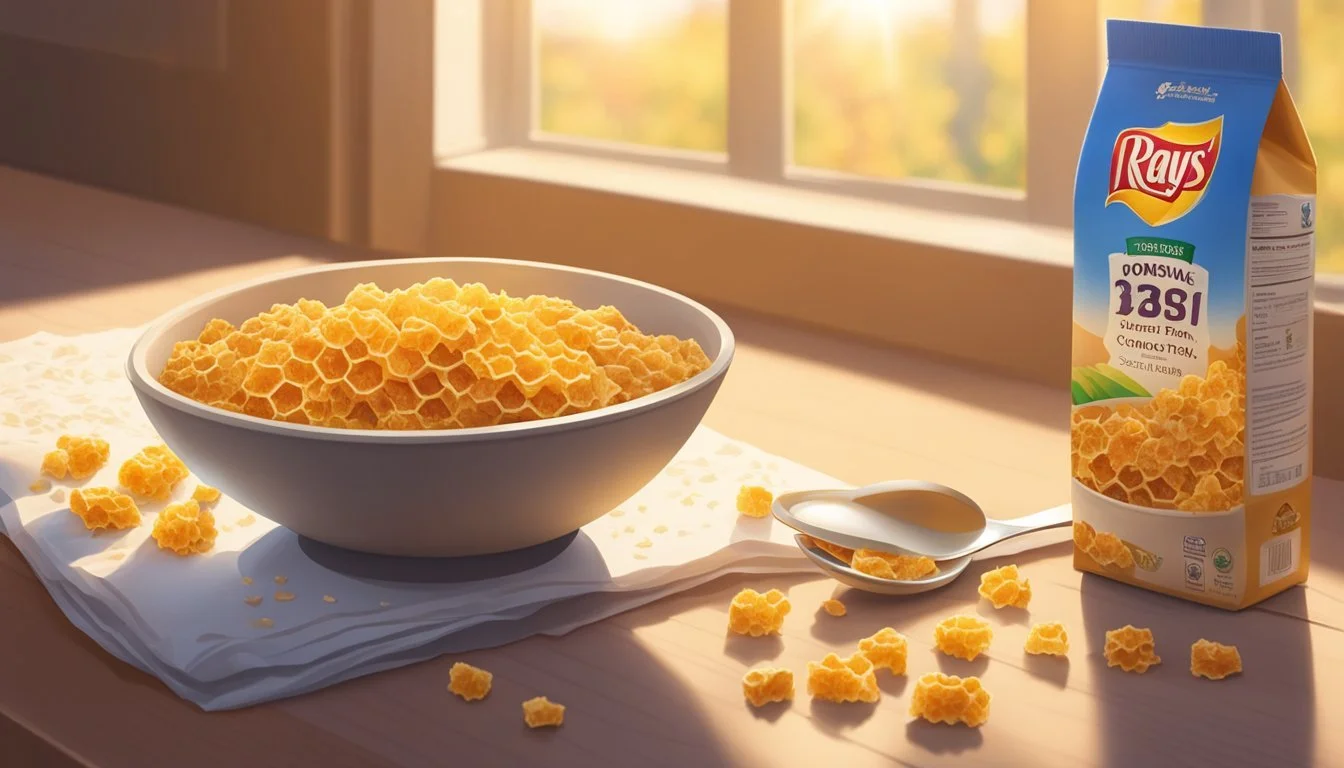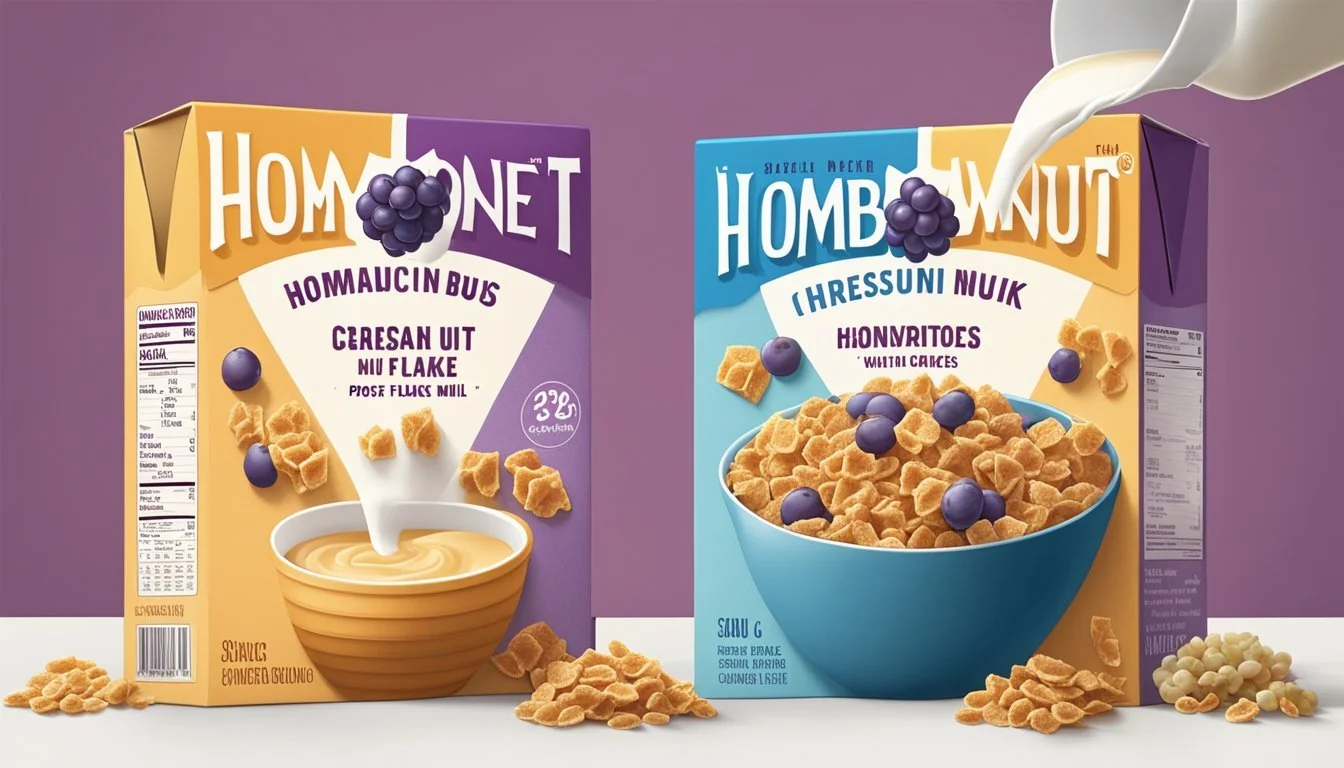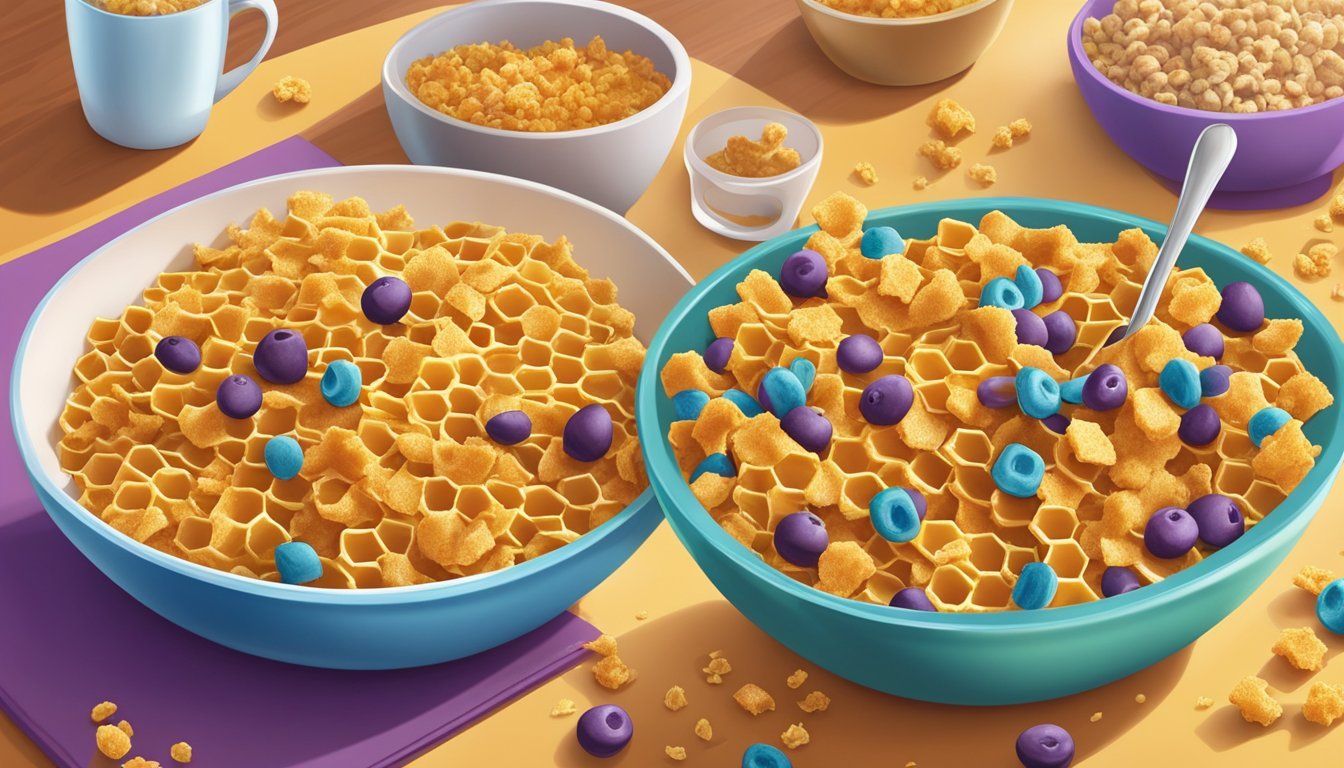Honeycomb vs Post Grape-Nut Flakes
A Detailed Cereal Comparison
Cereal lovers often find themselves at a crossroads, trying to decide between different healthy breakfast options. Honeycomb, known for its characteristic honey-flavored hexagonal pieces, is frequently pitted against Post Grape-Nuts Flakes, which feature crispy whole grain flakes. For those seeking a nutrient-dense start to their day, Post Grape-Nuts Flakes offer an edge with 15 grams of complex carbohydrates per serving.
While Honeycomb's sweet and light texture may appeal to those with a preference for sweeter breakfasts, it contains 14 grams of complex carbohydrates per serving. Post Grape-Nuts Flakes, in contrast, are loaded with essential nutrients and boast a hearty crunch. They are also known for their potential benefits in reducing the risk of heart disease due to their low saturated fat content.
These differences play a crucial role for anyone comparing the two cereals. Choosing between Honeycomb and Post Grape-Nuts Flakes ultimately depends on whether one's priority is a sweeter, lighter cereal experience or a heartier, nutrient-packed breakfast option.
Breakfast Cereal Fundamentals
Breakfast cereals are a staple in many diets, offering a quick and convenient meal option. These cereals have evolved significantly over time, embracing whole grains and catering to modern dietary preferences.
Definition and History of Cereals
Breakfast cereals are typically made from processed grains. They often come in various forms such as flakes, puffs, and shreds, and are usually consumed with milk or yogurt.
The origin of breakfast cereals dates back to the late 19th century. They were first developed as a health food by John Harvey Kellogg in response to the dietary needs of patients at the Battle Creek Sanitarium. Early cereals were quite plain but gradually became sweeter and more appealing to wider audiences.
Today, cereals often include added vitamins and minerals, high fiber content from whole grains, and low-sugar options to meet evolving dietary demands.
Whole grain cereals are particularly valued for their nutritional benefits. They provide essential nutrients, contribute to a healthy diet, and serve as a good source of fiber, which aids digestion and helps maintain healthy cholesterol levels.
From high-fiber options to fortified varieties, breakfast cereals play a significant role in a healthy morning routine.
About Honeycombs
Honeycomb cereal, known for its unique shape and long-standing presence in the market, has undergone various changes over the years. This section covers its overview, nutritional profile, and brand evolution to help readers understand its place in the breakfast cereal landscape.
Honeycomb Cereal Overview
Honeycomb cereal, produced by Post Foods, is recognized for its distinct hexagonal shape. It has been a staple in many breakfast routines since its introduction.
Originally marketed as a sweet cereal, it has maintained its appeal with a slightly honey-touched flavor. Honeycomb is often promoted for its large, crunchy pieces, making it a favorite among children and adults alike.
Nutritional Profile of Honeycomb Cereal
A typical serving size of Honeycomb cereal is 1 cup. Per serving, it provides around 120 calories. The cereal has 1 gram of protein per serving and minimal fiber content. It contains 14 grams of sugars and is relatively low in fats.
Nutritional Table for Honeycomb Cereal (per serving):
Calories: 120
Protein: 1g
Sugars: 14g
Fiber: <1g
Honeycomb is fortified with essential vitamins and minerals, contributing to its nutritional value despite its sugar content.
History and Brand Evolution of Honeycomb
Introduced in 1965 by Post Foods, Honeycomb has seen various marketing strategies and changes.
Early advertising campaigns often featured adventurous themes and mascots appealing to children. Over the years, the cereal underwent multiple recipe changes, which led to mixed reactions from consumers.
The original flavor was restored in response to customer demand, signifying the brand's adaptability and commitment to consumer satisfaction. This evolution highlights the cereal's resilience and sustained popularity.
Examining Post Grape-Nuts
Post Grape-Nuts Flakes are known for their whole grain goodness and nutritional benefits. This section explores their nutritional content, health benefits, and the unique flavor and texture that set them apart from other cereals.
Introduction to Grape-Nuts Flakes
Post Grape-Nuts Flakes are a variant of the original Grape-Nuts cereal. They provide a slightly different texture while maintaining the nutritional integrity of their predecessor.
Each serving consists of lightly crispy flakes made from whole grain wheat.
Grape-Nuts Flakes were designed to offer an easier-to-chew alternative to the original, which is known for its crunchy texture. This makes them accessible to a broader audience seeking the benefits of whole grains.
Health Benefits and Nutritional Information
Grape-Nuts Flakes are packed with nutrients. Per serving, they offer:
Calories: 150
Fat: 1.5 g (0 g saturated fat)
Sodium: 200 mg
Carbohydrates: 34 g
Fiber: 5 g (including both soluble and insoluble fiber)
Sugar: 7 g
Protein: 4 g
The combination of high fiber and protein contributes to prolonged satiety, making it a healthy breakfast choice. Additionally, diets low in saturated fat and cholesterol, such as one including Grape-Nuts Flakes, may reduce the risk of heart disease.
Grape-Nuts Flavor Profile and Texture
Grape-Nuts Flakes have a nutty and slightly sweet flavor. The whole grains contribute to a robust taste that distinguishes them from other more sugary cereals.
The texture is crispy yet much less dense compared to the original Grape-Nuts, providing an enjoyable experience for those who found the original too hard. This makes it a versatile option for breakfast, whether eaten with milk, yogurt, or as a snack on its own.
The unique flavor and texture of Grape-Nuts Flakes add to their appeal among health-conscious consumers and cereal enthusiasts alike.
The cereal's blend of taste and health benefits cements its place as a staple in many households.
Comparative Analysis
Grape-Nuts Flakes and Honeycomb cereals have distinct characteristics in terms of flavor, texture, and nutritional content. This section provides an in-depth comparison to help you choose between the two.
Taste and Texture Comparison
Honeycomb is known for its light, airy texture and mildly sweet flavor. The honey-flavored cereal appeals to those who prefer a less dense, crispy bite.
Grape-Nuts Flakes, on the other hand, have a more robust and hearty texture. The cereal retains a grainy, nutty taste, which can be quite crunchy. Some describe its texture as somewhat hard, which may not be suitable for all palates.
Overall, Honeycomb tends to be easier on the teeth and offers a sweetness that is more universally liked, while Grape-Nuts Flakes provide a stronger, more textured crunch that some enjoy.
Nutritional Breakdown
Nutrient Honeycomb Grape-Nuts Flakes Calories 110 per serving 110 per serving Complex Carbohydrates 14.0 grams per serving 15.0 grams per serving Sugar Moderately high Moderate Fiber Low Moderate Protein 1 gram per serving Higher protein content
Honeycomb offers 14.0 grams of complex carbohydrates per serving, while Grape-Nuts Flakes provide 15.0 grams. Both cereals have similar calorie counts, making them nearly equal in terms of basic energy contribution.
However, Grape-Nuts Flakes stand out slightly with a higher protein content, making them a better choice for those looking to increase protein intake. Honeycomb tends to have a higher sugar content which can be a consideration for those monitoring sugar consumption.
Consumer Preferences and Cereal Rating
In consumer polls, Honeycomb often scores higher for its flavor and texture, appealing to a broader audience, especially children and those with a preference for sweeter cereals.
Grape-Nuts Flakes, while well-regarded for their nutritional benefits, face criticism for their hardness and less sweet flavor profile. They are often preferred by health-conscious consumers who appreciate a more natural, less processed cereal.
When it comes to cereal ratings, Honeycomb tends to receive higher marks for taste and consumer satisfaction, while Grape-Nuts Flakes are praised primarily for their nutritional value and unique texture.
Dietary Considerations and Health Impact
When comparing Honeycomb and Post Grape-Nuts Flakes, key dietary factors include fiber content, sugar levels, and compatibility with specific dietary restrictions. Each cereal offers unique nutritional benefits but also carries distinct considerations.
The Role of Fiber and Whole Grains
Post Grape-Nuts Flakes provide 3.0 grams of dietary fiber per serving. This high fiber content supports digestive health and can aid in weight management.
Conversely, Honeycomb tends to have significantly less fiber, making it less effective for promoting regular digestion.
Whole grains are a vital component, with Grape-Nuts Flakes offering more whole grain goodness compared to Honeycomb. Diets rich in whole grains can lower risks of heart disease and improve long-term health.
Sugar Content and Its Effects
Honeycomb contains higher amounts of added sugars, which can negatively impact blood sugar levels and overall health when consumed in excess.
Post Grape-Nuts Flakes have minimal or no added sugars, making them a healthier option for avoiding unnecessary calorie intake and preventing issues like insulin resistance or weight gain.
Consuming lower sugar cereals can help maintain stable energy levels and prevent sugar crashes throughout the day.
Suitability for Restricted Diets
For those on restricted diets or aiming to eat heart-healthy, Post Grape-Nuts Flakes are preferable due to their lower sugar content and higher whole grain content.
Honeycomb, with more sugars and fewer whole grains, may be less suitable for such dietary needs.
Both cereals are generally free from trans fats and cholesterol, but Grape-Nuts Flakes offer a more balanced nutrient profile for those seeking heart-healthy options.
In terms of protein, Grape-Nuts Flakes also offer more, making them a beneficial addition to diets focusing on higher protein intake.
Cereal Preparation and Serving Suggestions
Understanding how to prepare and enjoy your cereals can greatly impact the experience. This section offers practical tips and creative ideas on serving Honeycombs and Grape-Nuts Flakes.
Classic Ways to Enjoy Honeycombs and Grape-Nuts
Honeycombs have a sweet, honey flavor that pairs well with milk. Pouring a typical serving size into a bowl and adding cold milk makes for a quick and crunchy breakfast. Grape-Nuts Flakes, on the other hand, have a denser texture and benefit from soaking in milk for a few minutes to soften them. This brings out a deeper malt flavor, while still providing a hearty crunch.
Adding raisins or other dried fruits to either cereal can enhance the natural sweetness and add a chewy texture. For those seeking extra nutrients, topping the cereals with fresh berries or a spoonful of Greek yogurt can be a nutritious addition.
Creative Recipe Ideas
For a unique twist, Honeycombs can be used in baking recipes such as cereal bars or as a topping for yogurt parfaits. Mixing Honeycombs with peanut butter and honey can make a delicious no-bake snack.
Grape-Nuts Flakes are versatile in cooking. They can be incorporated into muffin or bread recipes for added crunch and nutrition. Serving Grape-Nuts with warm milk, a practice known as "hot cereal," is an alternative for cold mornings.
Combining either cereal with other grains, nuts, and raisins in a homemade trail mix can create a portable, energy-rich snack perfect for on-the-go. These creative uses make the most of each cereal's unique qualities.
Consumer Information
Honeycomb and Post Grape-Nuts Flakes cereals offer consumers various purchasing options and contain distinct nutritional profiles. Understanding where to buy and how to interpret their nutrition facts are crucial aspects for making informed choices.
Availability and Purchasing Options
Both Honeycomb and Post Grape-Nuts Flakes are widely available in stores and online.
Consumers can find these cereals at major retailers such as Walmart, Target, and grocery stores.
For those preferring online shopping, platforms like Amazon and Walmart online also stock these cereals.
Post Consumer Brands, the manufacturer of Grape-Nuts Flakes, ensures distribution across the country, making the cereal accessible in most regions.
Similarly, Honeycomb’s widespread availability is facilitated by its manufacturer, Post Consumer Brands, ensuring it can be found easily in various locations.
Understanding Labels and Nutrition Facts
Reading and understanding nutrition facts is essential for making healthy cereal choices.
Grape-Nuts Flakes contain 15 grams of complex carbohydrates per serving, and Honeycomb has 14 grams.
Calories per serving differ, with Smart Start Original Antioxidants showcasing 240 calories per 1 1/4 cup serving, providing a helpful comparison point.
Nutritional labels provide insights into sodium levels, sugars, and fiber content. For example, Post Grape-Nuts Flakes have a higher sodium content, at 280 mg per serving, which is an important consideration.
Both cereals also list vitamins and minerals, essential for understanding their contribution to daily nutrient intake.
Antioxidants, fats, and protein levels are other critical elements mentioned on these labels, guiding consumers towards balanced diet choices.
Reviewing and comparing these nutrition facts helps in selecting the cereal that best fits individual dietary needs.
Environmental and Manufacturing Insights
Efforts to create sustainable cereal production are paramount for brands like Honeycomb and Post Grape-Nuts Flakes. The use of whole grains, efficient agricultural methods, and ingredient sourcing are critical aspects of their production processes.
Sustainable Practices in Cereal Production
Post Consumer Brands, the manufacturer of Grape-Nuts Flakes, emphasizes the use of whole grains. Whole grains are sourced responsibly to reduce environmental impacts.
Cereal production includes ingredients like grape seeds and flax, known for their health benefits and sustainable growth cycles.
Canola oil also plays a role, often chosen for its lower environmental footprint compared to other oils.
Both brands strive to implement conservation techniques throughout their supply chains to minimize waste and energy consumption. Efforts like these show their commitment to environmentally friendly practices.
Cereals in Popular Culture
Breakfast cereals have carved out a niche for themselves in popular culture, influencing everything from marketing to consumer nostalgia. Their presence in media and advertising reveals their significant role in daily life and childhood memories.
Advertising Campaigns and Brand Recognition
Advertising has undoubtedly played a critical role in popularizing breakfast cereals. Brands like Cheerios and Frosted Mini-Wheats are well-known for their memorable jingles and mascots. Cheerios, for instance, features heartwarming commercials focusing on family and health benefits, strengthening brand loyalty.
Grape-Nuts Flakes have a unique history, often spotlighted for their wholesome, rugged image. Many commercials emphasize their crunch and simplicity. Advertisements tend to highlight health benefits, aiming to appeal to adults looking for nutritious choices.
Innovative marketing tactics, like collectible toys and themed boxes, also capture children's attention. These elements make cereals not just a breakfast choice but an integral part of consumer culture.
The Rise of Nostalgic Cereal Trends
Nostalgia is a powerful force in the cereal industry. Many adults fondly remember the cereals of their youth and seek them out even in adulthood. This longing for the past has led to a resurgence of classic brands and limited-edition releases.
For example, the revival of certain Honeycomb designs and packaging taps into these feelings. Brands leverage nostalgia through retro packaging and re-releases of discontinued flavors.
Cereal cafes and online communities further showcase this trend. They celebrate these iconic breakfast staples by offering experiences centered around beloved cereals. This cultural shift reveals how cereals continue to shape and reflect shared cultural memories.









